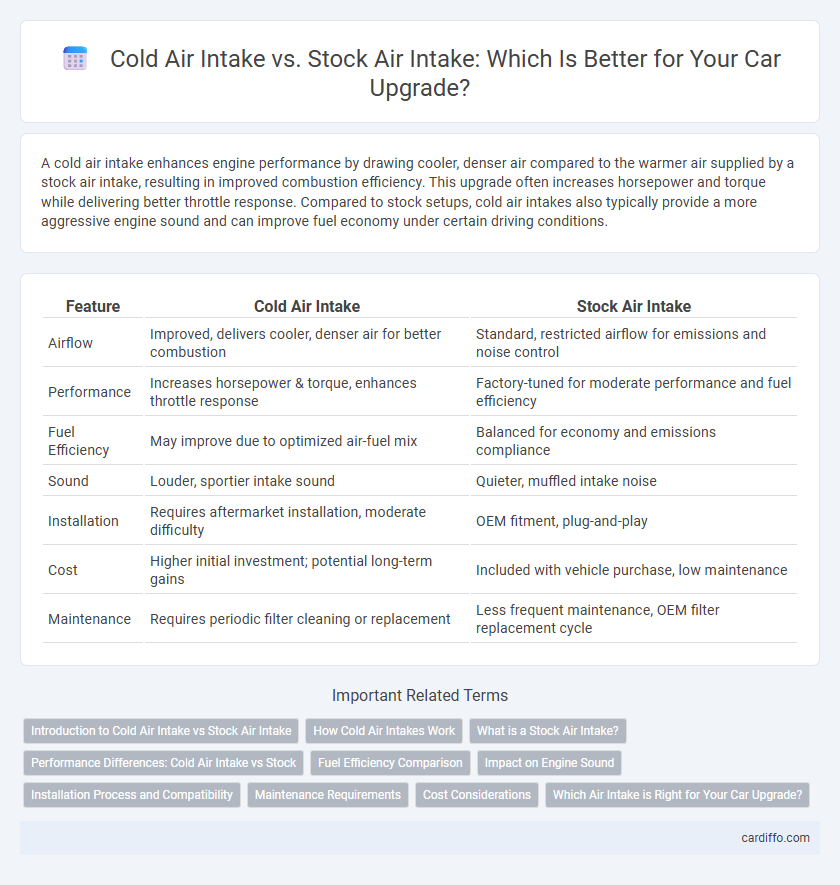A cold air intake enhances engine performance by drawing cooler, denser air compared to the warmer air supplied by a stock air intake, resulting in improved combustion efficiency. This upgrade often increases horsepower and torque while delivering better throttle response. Compared to stock setups, cold air intakes also typically provide a more aggressive engine sound and can improve fuel economy under certain driving conditions.
Table of Comparison
| Feature | Cold Air Intake | Stock Air Intake |
|---|---|---|
| Airflow | Improved, delivers cooler, denser air for better combustion | Standard, restricted airflow for emissions and noise control |
| Performance | Increases horsepower & torque, enhances throttle response | Factory-tuned for moderate performance and fuel efficiency |
| Fuel Efficiency | May improve due to optimized air-fuel mix | Balanced for economy and emissions compliance |
| Sound | Louder, sportier intake sound | Quieter, muffled intake noise |
| Installation | Requires aftermarket installation, moderate difficulty | OEM fitment, plug-and-play |
| Cost | Higher initial investment; potential long-term gains | Included with vehicle purchase, low maintenance |
| Maintenance | Requires periodic filter cleaning or replacement | Less frequent maintenance, OEM filter replacement cycle |
Introduction to Cold Air Intake vs Stock Air Intake
Cold air intake systems replace factory stock air intakes to improve engine performance by delivering cooler, denser air, resulting in increased horsepower and enhanced throttle response. Stock air intakes are typically designed for noise reduction and cost efficiency, often drawing warmer air from the engine bay, which limits performance potential. Upgrading to a cold air intake optimizes airflow and combustion efficiency, making it a popular modification for automotive enthusiasts seeking measurable gains.
How Cold Air Intakes Work
Cold air intakes enhance engine performance by drawing cooler, denser air from outside the engine bay, increasing oxygen levels for combustion. Unlike stock air intakes that pull warmer air from inside the engine compartment, cold air intakes reduce air temperature, improving throttle response and horsepower. This optimized airflow boosts engine efficiency and fuel economy by ensuring a more effective air-to-fuel mixture.
What is a Stock Air Intake?
A stock air intake is the factory-installed system designed to provide filtered air to the engine, optimized for general reliability and emission standards rather than peak performance. It typically features a restrictive air filter and tubing made from materials prioritizing cost-effectiveness and noise reduction. Compared to aftermarket cold air intakes, stock air intakes restrict airflow and limit engine breathing, resulting in lower horsepower and torque output.
Performance Differences: Cold Air Intake vs Stock
Cold air intakes improve engine performance by supplying cooler, denser air compared to stock air intakes, resulting in increased horsepower and torque. These systems often feature less restrictive filters and smoother airflow paths, enhancing throttle response and fuel efficiency. In contrast, stock air intakes prioritize noise reduction and emissions compliance but typically limit airflow, reducing overall engine performance potential.
Fuel Efficiency Comparison
Cold air intakes improve fuel efficiency by delivering cooler, denser air to the engine, enhancing combustion compared to stock air intakes that often draw warmer air from the engine bay. Cooler air increases oxygen content in the combustion chamber, resulting in better fuel atomization and more complete burning of fuel. Vehicles equipped with cold air intakes typically experience improved miles per gallon (MPG), indicating higher fuel efficiency than those using standard stock air intake systems.
Impact on Engine Sound
Cold air intakes significantly enhance engine sound by producing a deeper, throatier tone compared to the quieter, more muffled sound of stock air intakes. This upgrade allows more air to flow directly into the engine, amplifying intake noise and creating a more aggressive auditory experience. Enthusiasts often prefer cold air intakes for their ability to deliver a sportier sound without major modifications to the exhaust system.
Installation Process and Compatibility
Cold air intake systems feature straightforward installation, often requiring basic hand tools and minimal modifications, making them suitable for most DIY enthusiasts. Stock air intakes are designed specifically for the vehicle model, ensuring perfect compatibility but often involve more complex assembly due to integrated components. Compatibility varies as cold air intakes must match engine specifications and space constraints to avoid issues, while stock systems guarantee seamless fitment with existing factory settings.
Maintenance Requirements
Cold air intakes typically require more frequent maintenance compared to stock air intakes because their reusable filters need regular cleaning and oiling to maintain optimal airflow and filtration efficiency. Stock air intakes use disposable filters that are replaced less often, lowering maintenance time and cost. Proper upkeep of a cold air intake enhances engine performance and fuel efficiency by ensuring cooler, cleaner air delivery.
Cost Considerations
Cold air intake systems typically cost between $150 and $400, offering a balance of performance improvement and affordability compared to stock air intakes. Stock air intakes are integrated into the vehicle's original design, costing less upfront due to being factory-installed but potentially limiting engine efficiency gains. When upgrading, factor in installation costs and the potential for increased fuel efficiency that may offset the initial cold air intake investment over time.
Which Air Intake is Right for Your Car Upgrade?
Cold air intake systems improve engine performance by drawing cooler, denser air, increasing horsepower and fuel efficiency compared to stock air intakes designed for factory reliability and noise reduction. Choosing the right air intake depends on your car's model, driving conditions, and desired performance gains, with cold air intakes favored for aggressive driving and stock intakes providing consistent everyday use. Evaluating factors like engine compatibility, installation complexity, and maintenance will determine the best upgrade for your vehicle.
Cold air intake vs stock air intake Infographic

 cardiffo.com
cardiffo.com